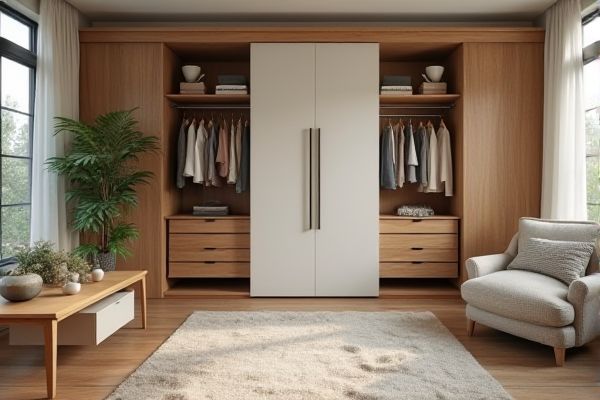
Reach-in closets offer open, customizable storage space ideal for organizing clothes and accessories efficiently, while armoires provide a stylish, freestanding solution that can be moved and often include drawers and shelves inside. Explore the rest of this article to determine which option best fits your storage needs and room design.
Table of Comparison
| Feature | Reach-In Closet | Armoire |
|---|---|---|
| Definition | A built-in, shallow closet accessible by opening one or two doors. | A standalone, decorative wardrobe cabinet for storing clothes. |
| Space Requirement | Requires wall space inside a room, typically recessed. | Freestanding; requires floor space but no wall recess. |
| Storage Capacity | Moderate; limited depth constrains bulky item storage. | Varies; deeper than reach-in, can hold bulky items. |
| Installation | Built-in during room design or remodeling. | Portable; no installation needed. |
| Customization | Customizable with shelves, rods, and organizers. | Limited customization; depends on the unit. |
| Cost | Typically cost-effective when included in construction. | Ranges widely based on design and materials. |
| Design Style | Simple, functional integration with room layout. | Varied styles; can be vintage, rustic, modern. |
| Mobility | Fixed installation, non-movable. | Portable and movable. |
Introduction to Reach-In Closets and Armoires
Reach-in closets offer built-in storage solutions that maximize space with customizable shelves, rods, and compartments, ideal for efficient organization. Armoires provide versatile, standalone furniture pieces featuring enclosed storage with doors and drawers, suitable for bedrooms lacking closet space. Both options enhance wardrobe management but differ in installation, design flexibility, and spatial impact.
Key Differences Between Reach-In Closets and Armoires
Reach-in closets are built-in storage spaces designed to maximize room efficiency with multiple hanging rods, shelves, and often sliding doors, ideal for compact or standardized spaces. Armoires, by contrast, are freestanding furniture pieces that offer flexible storage options including hanging spaces and drawers, making them portable and stylistically versatile. The primary differences lie in installation type, spatial footprint, and customization potential, with reach-in closets providing permanent, integrated solutions and armoires serving as movable, decorative storage units.
Space Requirements and Room Layout
Reach-in closets typically require less floor space than armoires, making them ideal for smaller rooms or apartments where maximizing vertical storage is key. An armoire demands a larger footprint and can serve as a freestanding furniture piece, allowing more flexibility in room layout and easy relocation. Choosing between the two depends on available square footage and whether built-in storage or movable cabinetry better suits the room's design and functional needs.
Storage Capacity and Organization Options
Reach-in closets provide extensive storage capacity with customizable shelving, hanging rods, and multiple compartments, maximizing space efficiency in a given area. Armoires offer versatile organization options with built-in drawers, shelves, and hanging space, suitable for smaller rooms or as standalone furniture pieces. The choice between the two depends on room size and specific storage needs, with reach-in closets excelling in overall capacity and armoires in decorative flexibility.
Design Flexibility and Customization
Reach-in closets offer superior design flexibility with customizable shelving, drawers, and hanging options tailored to individual storage needs, maximizing space efficiency. Armoires provide limited customization, typically featuring fixed compartments and a more rigid structure designed for portability and aesthetic appeal. Choosing a reach-in closet allows for optimized organization and adaptability, while armoires serve as stylish, standalone furniture pieces with less personalized storage solutions.
Installation Process and Portability
Reach-in closets require professional installation involving carpentry and custom fitting, making them a permanent fixture in your space. Armoires offer superior portability due to their freestanding design, allowing you to easily relocate or rearrange your storage. Choosing an armoire provides flexibility, while reach-in closets deliver a more integrated and stable storage solution.
Cost Comparison: Reach-In Closet vs Armoire
Reach-in closets generally offer a more cost-effective solution for storage as they utilize existing space with minimal investment, whereas armoires can be significantly more expensive due to their standalone design and premium materials. Custom-built reach-in closets may range from $1,000 to $5,000 depending on size and features, while armoires typically start around $800 and can exceed $3,000 for high-end models. Your choice depends on budget constraints and whether you prefer integrated storage or a movable furniture piece with aesthetic appeal.
Aesthetic Impact on Bedroom Décor
Reach-in closets offer a minimalist and streamlined aesthetic that seamlessly blends with modern bedroom decor, providing a clean and organized appearance by concealing clothes behind flat doors. Armoires serve as statement furniture pieces, featuring ornate designs or vintage styles that add character and decorative flair while also offering versatile storage. The choice between the two significantly influences the room's visual balance, with reach-in closets contributing to a subtle, integrated look and armoires enhancing the space with distinctive, eye-catching details.
Maintenance and Durability Considerations
Reach-in closets typically require less maintenance due to their built-in nature and durable construction materials like wood or drywall, which resist wear over time. Armoires, often made from solid wood or composite materials with decorative finishes, may need regular polishing and careful handling to prevent scratches and warping. Durability favors reach-in closets in environments with high humidity or frequent use, while armoires offer aesthetic appeal at the cost of potentially higher upkeep.
Choosing the Right Option for Your Needs
Reach-in closets offer customizable storage solutions with easy access and efficient organization, ideal for maximizing space in bedrooms or hallways. Armoires provide a stylish, freestanding option with enclosed compartments for clothing and accessories, perfect for rooms lacking built-in closet space. Assess your room size, storage requirements, and design preferences to select between the built-in convenience of a reach-in closet and the mobility and aesthetic appeal of an armoire.
 homyna.com
homyna.com